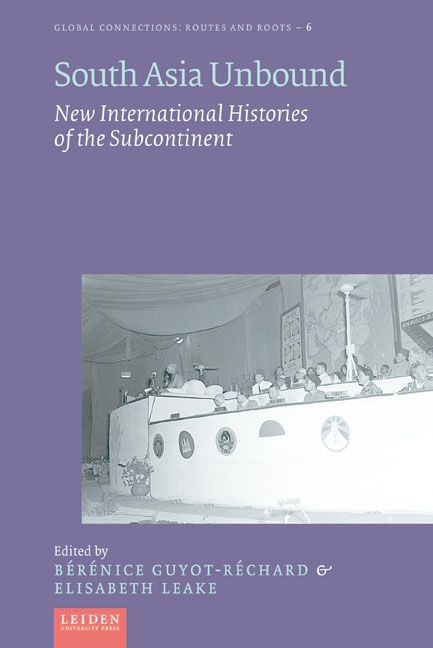Book contents
- Frontmatter
- Contents
- List of Illustrations
- List of Contributors
- Acknowledgements
- Acronyms and Abbreviations
- Introduction. South Asia Unbound
- Part I (Inter)national Orders and State Futures
- Part II From the Transimperial to the International: Lived Uncertainties
- Part III South Asian Roots of the International
- Part IV Ambivalences and Sensibilities of Internationalism
- Afterword
- Index
Chapter 8 - Fellow Travelers: Global Decolonization and Gandhian Peace Work
Published online by Cambridge University Press: 04 January 2025
- Frontmatter
- Contents
- List of Illustrations
- List of Contributors
- Acknowledgements
- Acronyms and Abbreviations
- Introduction. South Asia Unbound
- Part I (Inter)national Orders and State Futures
- Part II From the Transimperial to the International: Lived Uncertainties
- Part III South Asian Roots of the International
- Part IV Ambivalences and Sensibilities of Internationalism
- Afterword
- Index
Summary
Abstract This chapter shows how Gandhian peace workers connected to international pacifist circles in the 1950s and 1960s, particular the War Resisters’ International. Personal relationships forged between pacifists in India resulted in the Africa Freedom Action, an effort to bolster the decolonization process in Tanzania and Zambia. It is, however, also a story of disconnection: of Gandhian peace workers joining method, but not necessarily intent, with the War Resisters’ International. This disconnection was caused by the difference in weight that peace workers from different regions attached to decolonization as a prerequisite for world peace. As a result, the project developed a distinct Afro-Asian orientation, with peace workers in Dar es Salaam looking east, rather than west, for support.
Key words: peace movement, Cold War, decolonization, non-violence, internationalism, Afro-Asia
We are fortunate in India that we are not looked upon as cranks or stoned when we speak of World Peace. But in both cases, whether in the West or in India, as cranks or wise men, we are considered to be a group separated from the general community.
—Asha Devi AryanakamThe Gandhigram ashram sits nestled between the Sirumalai hills in the east and the Kodai hills in the west. It was founded by a Gandhian couple, Dr. and Mr. Ramachandran, who hoped to implement Gandhi's plan for the “reconstruction of the social order” in the villages of the Dindigul region, in central Tamil Nadu. Despite its remote location, the ashram's trajectory ran parallel to that of the country it sought to serve. Just weeks before independence, Chinnalapatti village had offered twenty-five acres of land to Dr. Ramachandran on which to build the ashram. A few weeks after independence, operations officially started. Like their counterparts in Delhi, the ashram's founders had long been active in the freedom struggle and were now eager to turn their focus to “constructive work,” the social uplift program set out by Gandhi. Within a few short years, the Bhoodan land reform movement would claim the attention of both.
Nevertheless, Gandhigram seldom looked towards Delhi, and the ashram's views on freedom were not framed in terms of political power or electoral politics. Their program was more ambitious both spatially and conceptually.
- Type
- Chapter
- Information
- South Asia UnboundNew International Histories of the Subcontinent, pp. 187 - 202Publisher: Amsterdam University PressPrint publication year: 2023

